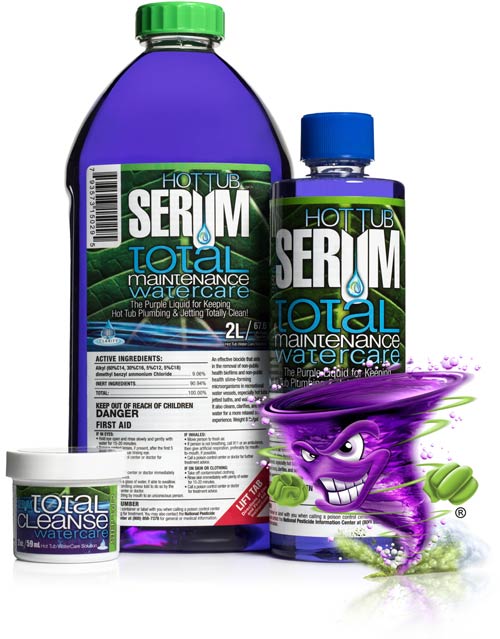One of the more common issues for hot tub owners is excessive foaming on the water surface in their spas. A bit of foaming is common and normal as the air in your spa jets will cause some modest foaming. However, this should dissipate quite quickly once you either close the air option for your jets or turn your spa off. If this foaming has not disappeared within 10 seconds or so, and particularly if it continues to build up as you operate your spa, you definitely have a water quality issue(s).
Foam Down
A product often suggested for dealing with foam is “Foam Down”. Seems perfect doesn’t it? It’s not. It’s simply a “band-aid” masking the real problem(s) in your spa. It does work as a surfactant (meaning it lowers the surface tension of the water), rather quickly actually, but it also lasts for about 20 minutes before you need another squirt in your spa. You keep adding more and more Foam Down, only adding more chemicals to your spa water, but you’ve not solved the fundamental problem.
What Causes Foaming In Your Spa?
There are essentially two reasons you may see foam in your spa. The first is just the normal buildup of what’s called TDS, or total dissolved solids. As you add sanitizing agents to your water, these chemicals accumulate in your spa water, resulting in higher and higher levels of TDS. Frankly, your use of your spa will also increase TDS. After several months, you simply have to drain and refill to again have water with lower TDS levels. By the way, as a rule of thumb, municipal water usually has around 50 – 200 ppm TDS.
Another cause of foaming is the introduction of foreign chemicals, or chemicals you do not want, to your spa. Body lotions, including suntan lotions, might be a cause. Another is phosphates.
Phosphates
Phosphate levels in the 0 – 200 ppb range are common in municipal water and won’t cause a problem. Note that this is ppb (parts per billion) rather than the ppm (parts per million) you use to measure everything else in your spa. Meaning, very low levels of phosphates can cause problems. In fact, 1 ppm (also 1,000 ppb) will definitely cause problems in your spa. You may not see foaming (as I note below in discussing calcium levels) but you will definitely have a problem maintaining a proper sanitizer level at 1 ppm of phosphates. Let me note that our Serum Total Maintenance kills bacteria and other pathogens in your spa water but, unlike chlorine and bromine, it’s not impacted by phosphate levels. Total Maintenance will continue to kill bacteria despite high phosphate levels.
More on Phosphates
Many people think detergents also contain phosphates. They commonly did back in the ‘70’s, until people realized they were also causing algae blooms in lakes and rivers. These days you are highly unlikely to find phosphates in your detergents.
However, phosphates definitely are in fertilizers and can actually be in your tap water. In agricultural areas that have been using phosphate fertilizers for decades it’s now in the ground water, hence in their wells.
Another sources of phosphates in tap water? It’s not all that common but some water districts deal with high metal content in their water by using metal sequestering agents that contain phosphates. Sequestering agents don’t directly remove metals, but they do render these metals inert. The problem is phosphate-based sequestering agents are cheaper than those that don’t contain phosphates.
More on Detergents
While your detergents are unlikely to contain phosphates, detergent residues in your clothing can still cause foaming. The best practice is to simply hang your swim clothes out to dry after using your hot tub, and not wash them.
Calcium
A certain level of calcium is usually present in tap water, usually in the 50 – 150 ppm range. Generally, you want 150 – 250 pm calcium in your spa water as it help protect the metal components in your spa from pitting. Because municipal water is often below this 150 – 250 ppm level, Calcium Booster is a rather common product in spa showrooms.
Calcium levels also impact the degree of foaming you might see in your spa as the higher the level of calcium the less likely you will see foaming. In fact, if your calcium level is in the 500-ppm range or higher you may never see foaming, no matter how messed up our spa water might be. On the other hand, if your calcium level is low (under 100 ppm) even modest levels of TDS or foreign chemicals may cause foaming. This means that foaming or lack of foaming in your spa is not a good indicator of your spa water quality. Foaming is a nuisance, but without also considering your calcium level, foaming is not a reliable indicator of spa water quality.
Thanks for reading,
Tony Turbo






